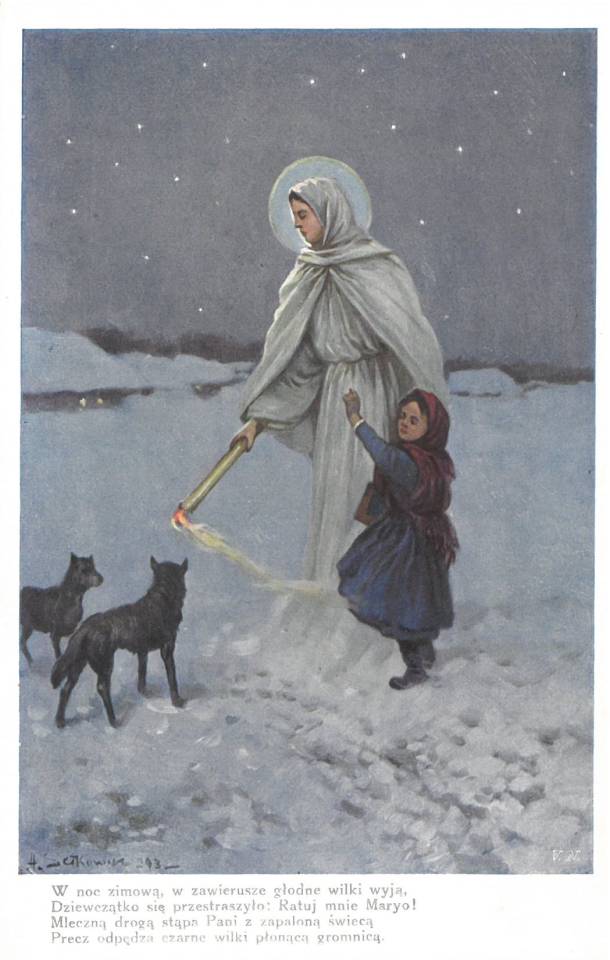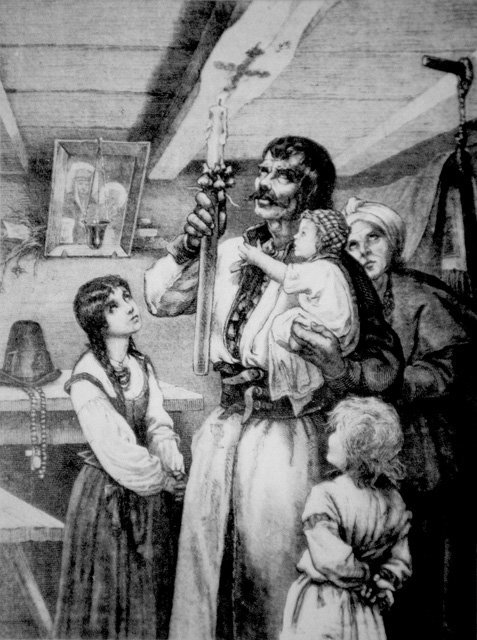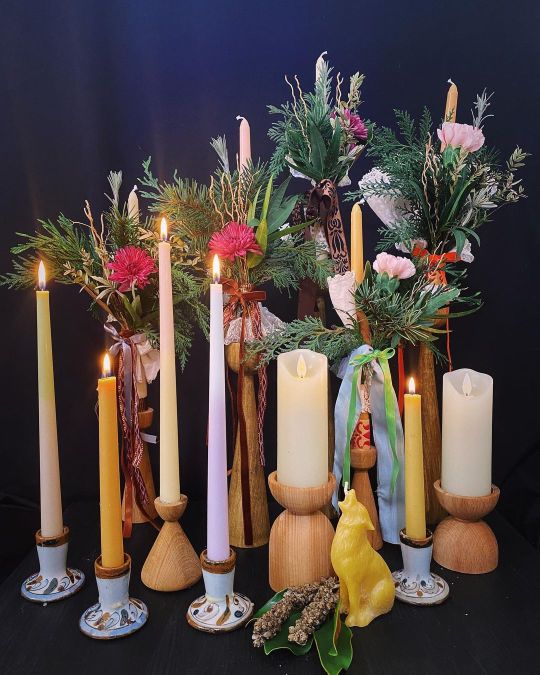#gromnica
Text

Growing up in the heart of the Balkans, I have been intimately woven into the tapestry of a unique ancient tradition known as Gromnica ( Gromnitsa) . Derived from the word "grom," which translates to thunder, and the creation of the Thunder Candle.
Gromnitsa, in particular, involves the sacred ritual of blessing candles and the creation of a distinctive candle known as the Thunder Candle (Gromnica) ." This candle, often adorned with intricate decorations, symbolizes the power of lightning or thunderbolt. Folklore says that the blessed candles and the Gromnitsa carry a protective aura, guarding against storms and malevolent energy. The Thunder Candle should be lit during hard thunderstorms or whilst someone in the household is ill, or on their deathbed.
Many lit candles are taken home to illuminate the household, symbolizing the spreading of light and the warming of the Earth, the awakening of Nature. Some communities also engage in processions or rituals meant to ward off evil and ensure a prosperous and safe year.
This centuries-old custom is intricately tied to the celebration of Candlemas, an event observed on February 2nd that blends Christian and pre-Christian customs. In the Eastern Orthodox Church, Candlemas marks the presentation of Jesus at the Temple and the purification of the Virgin Mary, symbolizing the triumph of light over darkness.
In modern times, the gromnice is stored away carefully for important ceremonies such as a christening, First Communion, Confirmation or Anointing.
While the name "Gromnica" might not be universally used across the entire Balkan region, variations of the Candlemas celebration are observed multiple countries. These customs highlight the cultural and religious diversity of the region, where ancient traditions intertwine with Roman-catholic and Orthodox practices and continue to this day.
.
.
.
.
.
#incense#male witch#gromnitsa#gromnica#catholic#orthodox#pagan#dark photography#ritual#occult#darksouls#stormwitch#faeriemagazine#traditional witchcraft#spirituality#slavic folklore#balkan witchcraft#balkan folklore
45 notes
·
View notes
Photo

Today just sending some good vibes in this (still) winter time. 🙌🕯❄️🌟 Light Blessings from your druid 😏❤️ Emrys /|\ #druidyzm #poganie #imbolc #gromnica #magic #magia #pagan #pagansofinstagram #druidry #druid #druidsofinstagram #obod #heathen #shaman #spiritualgrowth #oldways #tradition #paganismo #polishboy #occultism #witchcraft #witchyvibes #ovate #witchythings #gaypagan #czarostwo #wicca #malewitch #sorcerer #sorcery (w: Iława gmina) https://www.instagram.com/p/CoSfQ_vrkWB/?igshid=NGJjMDIxMWI=
#druidyzm#poganie#imbolc#gromnica#magic#magia#pagan#pagansofinstagram#druidry#druid#druidsofinstagram#obod#heathen#shaman#spiritualgrowth#oldways#tradition#paganismo#polishboy#occultism#witchcraft#witchyvibes#ovate#witchythings#gaypagan#czarostwo#wicca#malewitch#sorcerer#sorcery
0 notes
Text

Starting fire with the gromnica.
- Radom Ethnography Museum
#Candlemas Day#thunder candles#Poland#Folkways#Ancestors Alive!#What is Remembered Lives#Memory & Spirit of Place#old-Slavic protective rituals#rituals#Slavic Traditions#folklore#Lamus Dworski#gromnice#ancient ways#sacred ways#customs#traditions
2 notes
·
View notes
Photo

...wau, drobne, komorne "VŠVU the best year alumni rande" po fakt dost rokoch s Miloš Nemec Rudolf Látečka Martin Partl Martin Gromnica Vladimir Kratky Matus Marcek Alexander Smiesny Marcel Taranda, Jazmina Cigankova... BOLO FAKT👍👍👍👍👍👍👍👍👍👍👍👍👍👍👍 https://www.instagram.com/p/Cf2IBKRrnnh/?igshid=NGJjMDIxMWI=
0 notes
Text
Gromnica in Poland

On February 2nd Poles traditionally go to church to bless their thunder candles for the year. The holiday, nowadays devoted to Saint Mary as Our Lady of Candles is an adaptation of earlier, pre-Christian cultural traditions.The primary purpose of gromnica was of course to protect from lightning strikes, and subsequent fires. For that reason the candles would be placed in windows, doors or cattle-sheds during thunderstorms. On the 2nd of February upon the return from the church a sign of the cross would be either drawn or burned onto the window shutters and ceiling beams using the flame of freshly lit and consecrated gromnica.
This wasn’t however the end of the candle’s usefulness — gromnica was seen as a strong apotropaic tool that could be used for protection from wolves and wild animals, all kinds of devils and evil spirits, witches and malevolent magic and even certain sicknesses. Flax or hemp fibers/yarn/cloth could be tied around the thunder candles and taken to church to be consacrated alongside them — later it’d be tied around sick person’s neck to cure them of throat ache. The candle itself could allegedly be rubbed on any sore place to sooth the pain. Freshly lit gromnice were brought home from the church and used to lit up the hearth to ensure peace and accord in the family. Tips of children’s hair could be burned with it’s flames to bestow them with courage to weather literal and figurative storms. The thunder candle would also be lit to accompany the dying in their final hours, as a means of soothing the transition into the afterlife. When unused gromnica could be kept above the owner’s bed or — if such existed — on the household shrine, among holy images.
It has to be disclaimed that 1) abovementioned customs are a blend of pagan and Christian tradition that is very difficult to clearly separate and 2) when it comes to folk traditions like that of the thunder candles there’s a significant amount of regional variation at play — abovementioned cutoms do not all come from one region, I merely listed some of the more common themes of the holiday.

#gromnica#thunder candle#slavic folklore#polish folklore#slavic paganism#folk catholicism#folk christianity#saint worship
219 notes
·
View notes
Photo

G R O M N I C A ⧫ C A N D L E M A S :GROM: = Polish, “thunder” :THUNDER CANDLES: #Gromnica are special Polish candles created to be blessed + charged at Candlemas on 2/2. They were associated with the Slavic goddess of the hunt, Dziewanna/Devanna, protector of/protection from wolves and lightning, who became “The Holy Mother;’ her name means “mullein.” Mullein spikes were coated in beeswax + used as torches in springtime divination and other rituals, + became what the wicks were made of in the beeswax candles used for gromnica. They were often placed on window sills for protection, but were also personal candles: lit at important times like baptisms and on your deathbed, and put in your grave. They were dressed in linen, evergreen + ribbon. :CANDLEMAS: Halfway between winter and spring, appropriated by Christianity, early February marks the end of the Christmas-Epiphany season (when many Euro countries like Poland sing their last Christmas carol + take down the tree + decorations, sometimes burning them in a ritual fire). With the return of the light, #Candlemas arrives 40 days after the birth of Christ, + candles are blessed all over Christian Europe, but this tradition of course is much older and persists in folkways still. There were no guarantees people would survive the last harsh months before plants grew again and new animals were born. Candlemas tells of sacrifice + of gratitude for survival, and notably became important around the time of The Plague of Justinian around 541CE. :VIBES: #Mullein, torches, weather divination, beeswax, honey, wolves, youth/maiden, hunt, lightning, thunder, winter storms, wild nature, guidance for winter travels, gratitude, the moon. :RITUALS: Keep your Yule decor up until early February. Use them for your thunder candle. Candle decoration, anointing, blessing. Drip wax onto thresholds. Burn a shape onto your ceiling. Place in your window during a storm. Mullein spike torches. Gather your mullein seed for indoor starts. Simmer mullein on the stove, use in smoking blends. Protect + offer support to anyone who feels the effects of deep winter, of unexpected storms, of feeling of wolves at the door. More👇🏼 https://www.instagram.com/p/CZnPSEmPCnX/?utm_medium=tumblr
3 notes
·
View notes
Text
Is it bad that I find it a tad humorous that my grandmother died today... on Gromnica?
1 note
·
View note
Text


On that day (Feb 2nd) many Polish Rodnovers (Slavic Native Faith Believers) celebrate a feast of Dziewanna Gromniczna (Holy Mother/Dziewanna of the Thunder Candle) - lighting the ‘thunder candles’ in her honor in order to enrapture warmth for the second half of winter. Dziewanna, as the goddess of wilderness, is also asked for protection in the cold months (especially from the freezing weather or from attack of wild animals like wolves), and guidance during winter travels.
She’s then typically depicted with the so-called ‘thunder candle’ (gromnica), and often called a ‘Divine Mother with Wolves’ (Matka Boska z wilkami) or ‘Gromniczna [of the Thunder Candle] with Wolves’ (Gromniczna od wilków, Gromniczna z wilkami).
from: https://lamusdworski.wordpress.com/
8 notes
·
View notes
Note
Hello, I hope the first month of the new year is treating you well. I was wondering, do you celebrate Gromnica? Or a different holiday that would be equivalent to the Celtic sabbat: Imbolc?
thank you, and likewise!
and no, I don't.
2 notes
·
View notes
Link
Happy Bear Day to you all! 💛
February 2 is when Slavic people celebrate Gromnica or Bear Day. It is a Slavic equivalent to Imbolc.
Today, in christianized Poland "gromnica" means a huge candle that people use during the most important catholic celebrations like christening or praying for the deceased before the funeral. But the word "gromnica" actually comes from "grom" which means thunder.
On February 2 we light candles as a symbol of light conquering darkness and from this day on we can start expecting the first thunders - a sign of Spring approaching, a sign that Perun conquered the Snake that bound the waters for winter. The first thunderclap is a sign that Mokosh (Earth) is ready to be fertilized - it'd be ideal for the thunder to happen between today and spring equinox.
(The bear statue above is a small replica of the original bear statue that stands for thousands of years on top of our holy Mount Ślęża.)
0 notes
